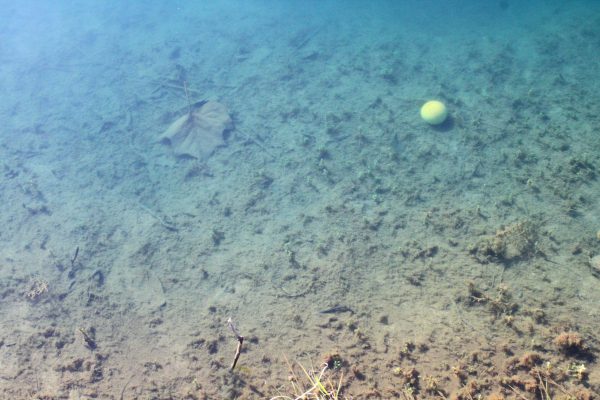Unedited photo showing the color of the pond in front of the Goode Center.
McKenna Howenstine|Marlin Chronicle
Virginia Wesleyan uses ProcellaCOR, an FDA “reduced risk” algicidal dye, to give campus ponds their blue hue and to prevent harmful algae growth.
Virginia Wesleyan University dyes almost all of the ponds blue, and they have been doing this for a long time. The pond management contractor, Solitude Lake Management, uses ProcellaCOR, a dye that was first used in VWU water in 2017 and has an algicidal active ingredient, florpyrauxifen-benzyl.
“This has been part of pond management 101 for years,” Jason Seward, associate vice president for Campus Life and Operational Management, said. He said it was “not at all” dangerous.
The EPA has registered florpyrauxifen-benzyl as “reduced risk,” which means it is less toxic than existing registered alternatives. There are no restrictions on fishing, drinking or recreation activities in water treated with ProcellaCOR. The algicide florpyrauxifen-benzyl is an organic molecule and has a formula of C20H14Cl2F2N2O3. It contains two fluorinated carbons, which can be seen in the C-F bonds on the diagram, but the compound is not a PFAS (often known as “forever chemicals”) according to the EPA and most definitions, which require a chain of fluorinated carbons.
“There are many benefits to pond dying—you can do a quick google search,” Seward said.
A study by Alisha Davidson, funded by the Great Lakes Aquatic Research and Management, found that florpyrauxifen-benzyl was effective at treating lakes for Eurasian milfoil (Myriophyllum spicatum), a common invasive species. Mean species richness (biodiversity and the health of the ecosystem) increased after treatment. Other studies showed similar results and little to no effect on wildlife, although the chemical has yet to undergo rigorous testing on a broad scale.
The lakes at Virginia Wesleyan are BMPs, or Best Management Practices, according to Seward. The lakes serve the function of absorbing stormwater runoff and increasing healthy percolation over storm drains.

Illustration of dye bottle
Mars Johnson|Marlin Chronicle
Marco Molino, a senior Biology major, studied heavy metal pollution in lakes on campus fall of 2023. He found an increase in copper and chromium concentrations in the “fountain ponds” over the retention ponds by Greer, “Copper specifically.” There was a “pretty distinct difference” between the two systems. He said one cause might be algicides containing copper, which is harmful to marine life. ProcellaCOR does not contain copper. The retention ponds are managed by Norfolk Botanical Gardens and do not use dye.
Seward said that the school has been contracting with Solitude “as long as I can remember,” at least since 2017 and probably “further back than that.” The Marlin Chronicle attempted to contact Solitude via phone, but the representative was unaware of the treatment that Solitude used before ProcellaCOR, which was classified by the FDA as “reduced risk” in 2017. In any case, it is very unlikely for copper treatments from seven years ago to be affecting copper levels. The levels are likely due to some other cause.
“I have not yet heard of any problem [with using pond treatments]”, Dr. Maynard Schaus, professor of Biology and Environmental Science and the coordinator of Sustainability Management, said. He sent the Marlin Chronicle several research articles on pond dye (specifically Aquashade, which has no algicidal component beyond darkening the water to impede photosynthesis) and copper treatments. These articles supported his position, as did research done by the Chronicle, which found conflicting positions but no significant evidence that ProcellaCOR was harmful.
“It’s an environmentally friendly product, because that’s important to us,” Seward said. Virginia Wesleyan has a commitment to sustainability that can be seen in the Green Environmental Center and the natural garden surrounding it.
In addition to the ProcellaCOR, the school takes other measures for pond health. Fountains, which are often seen as purely aesthetic, contribute to aeration or introducing air into the lake. This process can be accomplished by other ways, but “most people just put in a fountain because it looks pretty,” Schaus said.
This mirroring of aesthetics and lake treatment is expressly part of the process. Seward mentioned on multiple occasions that the dye was “more aesthetically pleasing.” He made a point to say that a blue lake is both prettier and more environmentally friendly than a lake covered with a green film and no fish, which would likely happen were algae to be allowed to grow out of control.

Florpyrauxifen-benzyl, the active ingredient, an algicide, in ProcellaCOR
Victoria Haneline|Marlin Chronicle
Since the lakes “absorb excess stormwater,” Schaus said, it is often “easier to just manage it with Aquashade.” The lakes’ function as BMPs could reasonably necessitate treatment and introduce difficulties in managing it naturally.
“The active use of algaecide is always going to be less perfect than finding ecological balance, like in the retention ponds,” Molino said. He said that a possible contributor to the necessity of algaecide would be the grass monoculture surrounding the lakes, as opposed to the retention ponds having native plants. He said he was “always a proponent of reducing monocultures.”
In a healthy, non-monoculture environment, “nutrient balance tends to self-equalize,” Molino said.
Even in healthy environments, many large lakes suffer incursions of algae, often to a much greater detriment than using pond dye might cause.
A study by Lamb et al. called “Monitoring and water quality impacts of an herbicide treatment on an aquatic invasive plant in a drinking water reservoir” found that ProcellaCOR reduced coverage of Yellow Floating Heart (Nymphoides peltata) substantially in a drinking water reservoir in Stillwater, OK.
Pond dye is often used for aesthetic purposes, and is likely to be unpopular among environmental proponents. Molino objected to it “on principle.” There are certainly alternatives, such as those used in the Greer retention ponds, which do not involve pond dye, although they might be unsuitable for the larger BMP lakes on campus. In any case, existing research shows that ProcellaCOR causes little harm and is almost certainly better than algae blooms.
By Victoria Haneline


